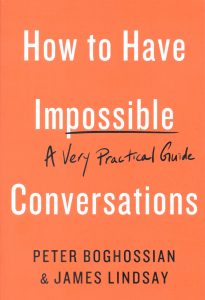The one sentence summary
It is possible to have productive conversations even with people with entrenched views if you foster a climate of civility, connection and empathy.
Can’t be bothered to read it? Too much screen time lately? Listen to the 5-minute podcast in two parts.
WHAT THE BOOK SAYS 
- Heated debates often lead to insults and shaming, blocking productive discourse. But if you develop practical conversation techniques you can learn the subtle art of instilling doubts and opening minds. The fundamentals are:
- Goals. Why are you engaged in this conversation?
- Partnerships. Be partners, not adversaries.
- Rapport. Develop and maintain a good connection.
- Listen. Listen more, talk less.
- Shoot the messenger. Don’t deliver your truth – it’s not your job to convert people.
- Intentions. People have better intentions than you think.
- Walk away. Don’t push your conversation partner beyond their comfort zone.
- If you want to start changing people’s minds, try these techniques:
- Modeling. Model the behaviour you want to see in others.
- Words. Define terms up front (people use words like faith, belief etc. differently)
- Ask questions. Focus on a specific question.
- Acknowledge extremists. Point out bad things that people on your side of the argument do.
- Navigate social media. Do not vent on it.
- Don’t blame, do discuss contributions. Shift from blame to contribution.
- Focus on epistemology (the investigation of what distinguishes justified belief from opinion). Figure out how people know what they claim to know.
- Learn. Learn what makes someone close-minded.
- What not to do: be discourteous, display anger, raise your voice, talk over someone, ridicule or blame, accuse someone of being stupid, etc.
- More advanced skills include:
- Rapoports’ Rules.* Re-express their views, list points of agreement, mention what you learned, only then rebut.
- Avoid facts. Do not bring them into the conversation because most people’s opinions aren’t based on them.
- Yes, and. Remove the word ‘but’ from your spoken vocabulary.
*Rapoport was a Russian-born American game theorist.
WHAT’S GOOD ABOUT IT
- Parallel talk is taking something someone says and using it to reference yourself or your own experiences. Don’t do this.
- Pauses in conversation (lacunas) should be viewed as opportunities, not uncomfortable silences.
- The goal of an intervention is to help people become less confident about what they believe.
- The Unread Library Effect is when people think they know more about something than they actually do – they believe they have all the ‘books’ (facts and information), but they haven’t read them.
- Superordinate identities are broad categories that are helpful to reframe conversations through common ground – American, human, parents etc.
- A powerful intervention is: “On a scale of 1 to 10, how confident are you that X is true?”
- Disconfirmation is the process or result of disconfirming a hypothesis. Try questions such as “Under what conditions could the belief be false?” and “How could that belief be wrong?”
- Those whose views cannot be revised are said to experience epistemic closure or doxastic closure.
- Interesting is a good word to start a response with because it encourages further investigation. However is another – it’s not offensive.
- Altercasting is a persuasion technique in which the other person is cast into an alternate role from which it is easier for them to be influenced.
- An identity quake is the emotional reaction that follows from having one’s core values disrupted.
- Build golden bridges: find ways for your conversation partner to avoid social embarrassment if they change their mind.
WHAT YOU HAVE TO WATCH
- Not much, but be aware that the techniques become significantly more sophisticated as the book progresses.
